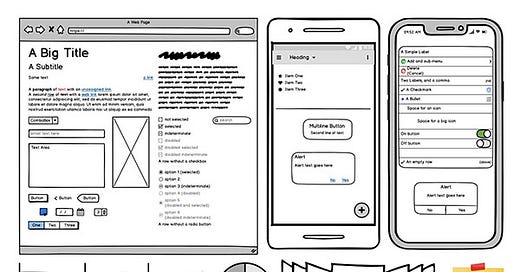Hi, this is Evelyn from Thinker & Co, a newsletter with Short Notes on Design Thinking (Light), Human+Tech Systems, Innovative Product Design and Development, and Being a Solopreneur.
Once upon a time, wireframing meant firing up my Visio. These days, with a dazzling line-up of wireframing tools in the market, it’d be smart to start with asking “What am I trying to do? What are my requirements? Anything free out there - and if I have to pay, what really justify the cost?”.
And with that, I found myself re-examining my own requirements last week, followed by a rapid round of compare-shopping.
The winner surprised me.
Hello, good old Balsamiq!
Not joking about it being “old” - Balsamiq was released in 2008! To still be around is amazing, to be on various current recommendation lists (here, here, here) really speaks to the strength of this tool.
Balsamiq bills itself as a “rapid low-fidelity UI wireframing tool that reproduces the experience of sketching on a notepad or whiteboard, but using a computer.” It’s deliberately positioned to be different from tools that “add complexity”.
With its cartoon-ish appearance, one may wonder if Balsamiq is fit to be used in a corporate environment.
The answer is a resounding yes!
I last used Balsamiq while building an online learning system for a corporate client (CBC).
Below is one of the many wireframes produced. Totally napkin-sketch-y, right?
These super-low-fi wireframes fulfilled a beautiful role in the early stage of the project when the team made key decisions including feasibility, functions, content, UI, database design, stakeholder deliverables, and way more.
To the designer, it explained the kind of “stuff” that would be there and how a user interacted with the interface
The backend developer immediately considered the database architecture that needed to be built or modified for that experience to happen.
The clients - project manager and head of elearning - used the wireframe to visualize requirements, identify missing content, make go/no-go decisions, etc.
Low-fi drawings win by providing less - everyone instantly understands this is not the final product, so the focus is placed on critical elements (function, user interaction, content). No one gets distracted by the wrong colour combination, or worries about signing off something that is cast in stone.
Another big benefit is how little time was spent on mocking up various rounds for reviews for approval. In the old Visio days, I had to keep up an appearance of perfection (a single out-of-place element stood out). With Balsamiq, I could get to the point without quasi-design anything.
The team was totally virtual. At that time, collaborative whiteboard or zoom was not the norm. These wireframes were simply emailed to the client team and walked-through over conference calls. I’d imagine if done today, using Zoom and sharing the screen, the wireframe walkthrough would be an even better experience.
As I revisited Balsamiq, I am glad the company has stayed true to its core values. Dead serious about staying super low-fi, Balsamiq design elements remain hand-drawn sketch style all these years. The new (to me) “clean wireframe” option (see below) is still very casual compared to the sophisticated lines and shapes typical of most wireframing tools. They get the job done, as illustrated in my project experience with CBC.
To conclude, Balsamiq is a tried-and-tested tool I’d recommend to anyone who needs to quickly visualize the UI and user interaction during early stages of a design project or startup. At $9 a month, it is well within the “budget” category of project tools.
I look forward to sharing more personal reviews with you as I continue to explore the world of project tools for solopreneurs.






